What Numbers Do You Read on Computer Memory
RAM is the curt-term retention of your reckoner. It'due south where your computer keeps track of the programs and data you're using correct now. You probably already know that more RAM is better, simply peradventure y'all're looking to install more RAM at present.
Shopping for RAM tin be confusing, though. What's the deviation between DDR3 and DDR4? DIMM then-DIMM? Is there a difference betwixt DRR3-1600 and PC3-12800? Is RAM latency and timing important?
Read on for explanations on the unlike kinds of RAM, how to read RAM specifications, and exactly how RAM works.
What Is RAM?
RAM stands for Random Access Memory. Information technology acts as a eye ground between the small-scale, super-fast cache in your CPU and the large, super-slow storage of your hard drive or solid-state drive (SSD). Your system uses RAM to store working parts of the operating arrangement temporarily and the data your applications are using actively. RAM is not a form of permanent storage.
Think of your computer as an part. The hard drive is the filing chiffonier in the corner. The RAM is like an entire function workstation, while the CPU cache is like the actual working area where you actively piece of work on a document.
The more RAM you lot accept, the more things you can have quick access to at any one fourth dimension. Just as having a bigger desk tin can hold more than bits of newspaper on it without becoming messy and unwieldy (as well as requiring more trips back to the filing cabinet to reorganize).
Dissimilar an office desk-bound, all the same, RAM cannot human activity as permanent storage. The contents of your system RAM are lost as soon every bit you turn the ability off. Losing power is like wiping your desk clean of every certificate.
RAM Normally Means SDRAM
When people talk well-nigh RAM, they're ordinarily talking about Synchronous Dynamic RAM (SDRAM). SDRAM is what this article discusses, too. For virtually desktops and laptops, RAM appears as a stick that you can insert into the motherboard.
Unfortunately, at that place is a rising tendency for super sparse and lite laptops to have the RAM soldered to the motherboard directly in the interest of saving space. However, this sacrifices upgradability and repairability.
Do not misfile SDRAM with SRAM, which stands for Static RAM. Static RAM is the retentivity used for CPU caches, among other things. It is much faster but also express in its capacity, making information technology unsuitable as a replacement for SDRAM. Information technology is highly unlikely you will encounter SRAM in general usage, so information technology is not something you should worry near.
The Course Factors of RAM
For the most function, RAM comes in two sizes: DIMM (Dual In-Line Retentiveness Module), which is found in desktops and servers, and SO-DIMM (Pocket-size Outline DIMM), which is found in laptops and other small grade factor computers.
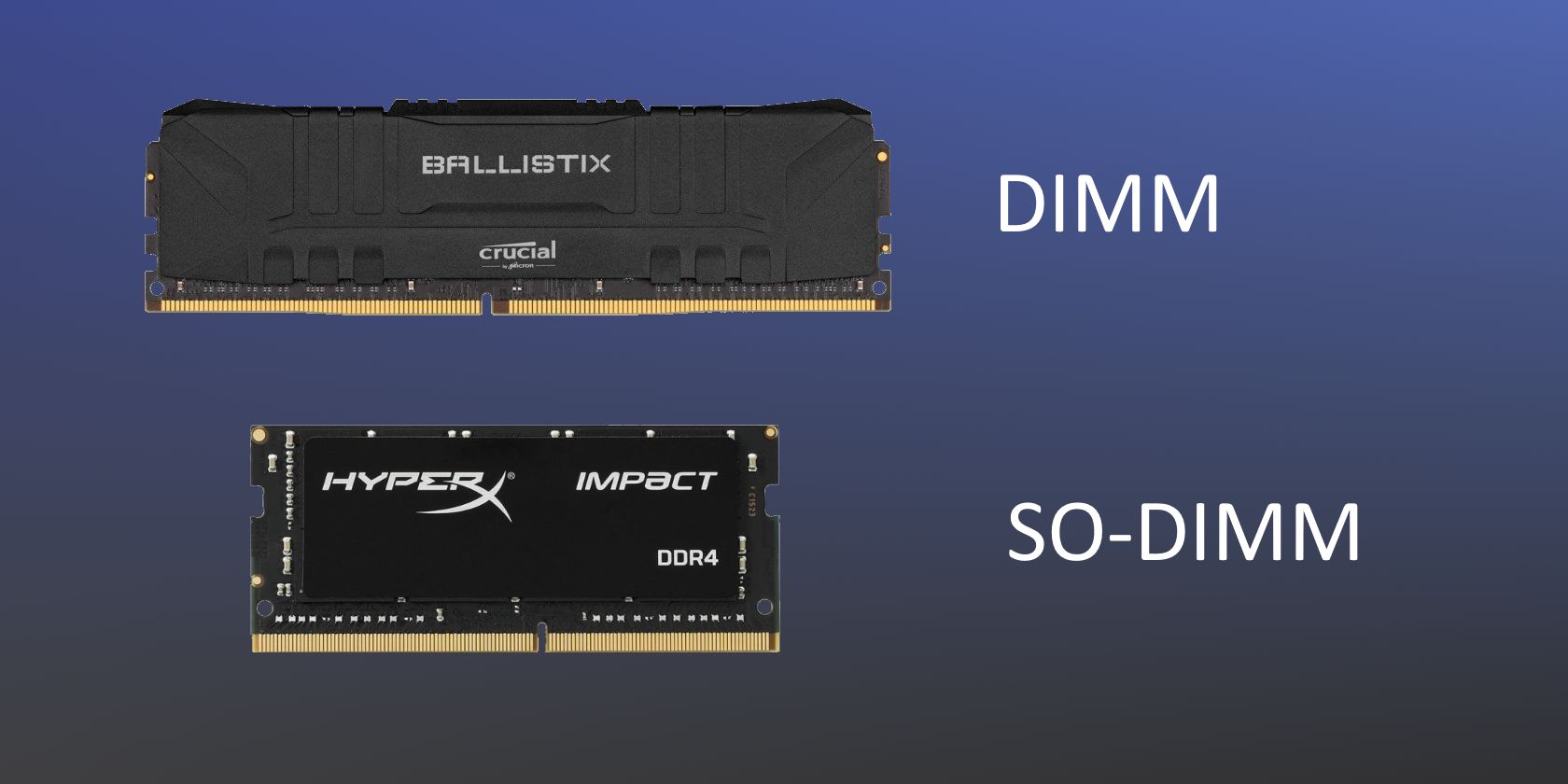
Though the two RAM course factors use the same technology and functionally work in exactly the same mode, you cannot mix them. You can't simply jam a DIMM stick into a SO-DIMM slot, and vice versa (the pins and slots don't line upward!).
When you lot are ownership RAM, the first thing to figure out is its grade factor. Nothing else matters if the stick won't fit!
What Does DDR Mean?
The RAM you use in your reckoner operates using Double Information Charge per unit (DDR). DDR RAM means that two transfers happen per clock cycle. Newer types of RAM are updated versions of the aforementioned technology, hence why RAM modules carry the label of DDR, DDR2, DDR3, then on.
While all desktop RAM generations are the same physical size and shape, they aren't uniform.
You cannot utilise DDR3 RAM in a motherboard that only supports DDR2. Likewise, DDR3 doesn't fit in a DDR4 slot. To end whatever confusion, each RAM generation has a notch cut in the pins at different locations. That means you lot cannot accidentally mix your RAM modules up or impairment your motherboard, even if yous buy the wrong type.
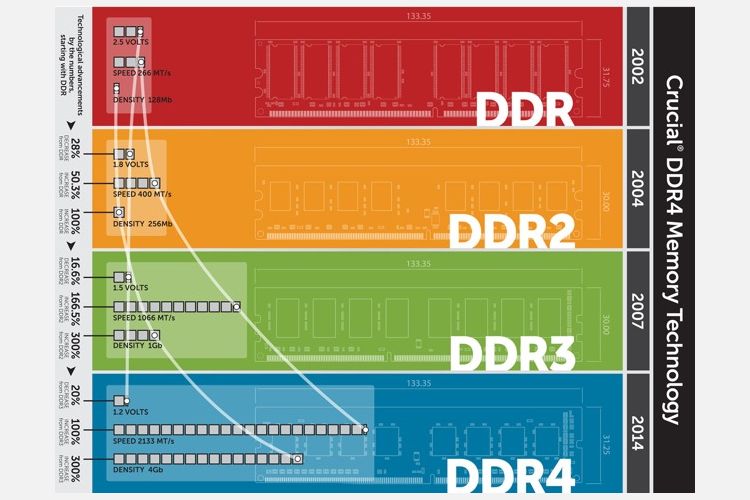
DDR2
DDR2 is the oldest kind of RAM you're likely to come beyond today. It has 240 pins (200 for And so-DIMM). DDR2 has been well and truly superseded, but you can still purchase it in express quantities to upgrade older machines. Otherwise, DDR2 is obsolete.
DDR3
DDR3 was released way dorsum in 2007. Although DDR4 officially superseded information technology in 2014, you will withal find many systems using the older RAM standard. Why? Because it wasn't until 2016 (two years afterwards DDR4 launched) that DDR4 capable systems really picked upward steam.
Furthermore, DDR3 RAM covers a huge range of CPU generations, stretching from Intel's LGA1366 socket through to LGA1151, as well as AMD's AM3/AM3+ and FM1/two/2+. For Intel, that covers the Intel Cadre i7 line introduction in 2008 through to the seventh generation Kaby Lake CPUs in 2016.
DDR3 RAM has the same number of pins as DDR2. However, it runs a lower voltage and has higher timings (more on RAM timings in a moment), so it isn't compatible. Also, DDR3 SO-DIMMs have 204 pins versus DDR2's 200 pins.
DDR4
DDR4 hit the market in 2014 and took some fourth dimension to become the well-nigh pop type of RAM, taking the meridian-spot from DDR3 onetime in 2017. Since then, DDR4 utilize has steadily grown to the point where information technology at present accounts for around fourscore percent of all RAM sales worldwide.
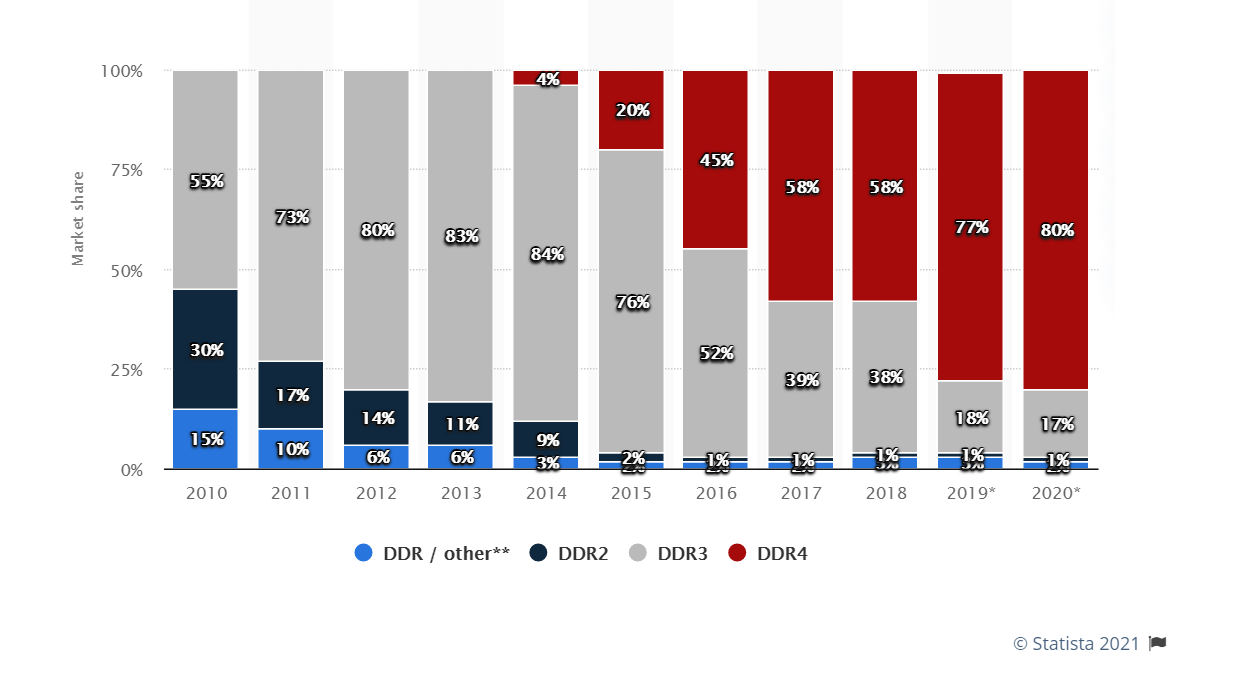
An initial period of high prices saw many users stick with the previous generation. Still, as the latest Intel and AMD CPUs use DDR4 RAM exclusively, near users have switched to the new generation or will upgrade the adjacent time they update their system hardware.
DDR4 drops the RAM voltage even further, from 1.5V to one.2V, while increasing the number of pins to 288.
DDR5
DDR5 was set up to hit consumer markets in 2019. That didn't happen. It didn't really happen in 2020, either, as the new memory spec was only released in mid-2020. The outcome is that at the time of writing, DDR5 RAM is just starting to filter out into the world, simply merely past way of expensive showcase modules rather than consumer-grade products.
DDR5 volition continue with a 288-pin pattern, although the RAM voltage will drop to 1.1V. DDR5 RAM functioning is expected to double the fastest standard of the previous DDR4 generation. For instance, SK Hynix revealed the technical details of a DDR5-6400 RAM module, the fastest possible immune nether the DDR5 standard.
But, as with whatsoever new reckoner hardware, expect an extremely high price at launch. Besides, if you're considering buying a new motherboard, don't focus on DDR5. It isn't bachelor yet, and despite what SK Hynix says, it will have Intel and AMD a while to prepare
RAM Jargon: Speed, Latency, Timing, and More
You've wrapped your head around SDRAM, DIMMs, and DDR generations. But what most the other long strings of numbers in the RAM model? What do they hateful? What is RAM measured in? And what near ECC and Swap?
Here are the other RAM specification terms you demand to know.
Clock Speed, Transfers, Bandwidth
Y'all may have seen RAM referred to past two sets of numbers, like DDR3-1600 and PC3-12800. These both reference and allude to thegeneration of the RAM and itstransfer speed. The number after DDR/PC and before the hyphen refers to the generation: DDR2 is PC2, DDR3 is PC3, DDR4 is PC4.
The number paired after DDR refers to the number of megatransfers per 2d (MT/s). For example, DDR3-1600 RAM operates at i,600MT/southward. The DDR5-6400 RAM mentioned above volition operate at half-dozen,400MT/s—much faster! The number paired after PC refers to the theoretical bandwidth in megabytes per 2d. For example, PC3-12800 operates at 12,800MB/due south.
It is possible to overclock RAM, just like you can overclock a CPU or graphics card. Overclocking increases the RAM's bandwidth. Manufacturers sometimes sell pre-overclocked RAM, but you can overclock it yourself. Just make sure your motherboard supports the higher RAM clock speed!
Yous might be wondering if you can mix RAM modules of dissimilar clock speeds. The answer is that yes, you tin can, but they'll all run at the clock speed of the slowest module. If you want to use faster RAM, don't mix information technology with your older, slower modules.
You can, in theory, mix RAM brands, just information technology isn't appropriate. Y'all run a greater take chances of encountering a bluish screen of decease or other random crashes when y'all mix RAM brands or unlike RAM clock speeds.
Timing and Latency
Yous will sometimes see RAM modules with a serial of numbers, like nine-10-9-27. These numbers are referred to as timings. A RAM timing is a measurement of the performance of the RAM module in nanoseconds. The lower the numbers, the quicker the RAM reacts to requests.
The beginning number (nine, in the instance) is the CAS latency. The CAS latency refers to the number of clock cycles it takes for data requested by the retentivity controller to become available to a information pin.
You might notice that DDR3 RAM more often than not has higher timing numbers than DDR2, and DDR4 mostly has college timing numbers than DDR3. Nevertheless, DDR4 is faster than DDR3, which is faster than DDR2. Weird, correct?
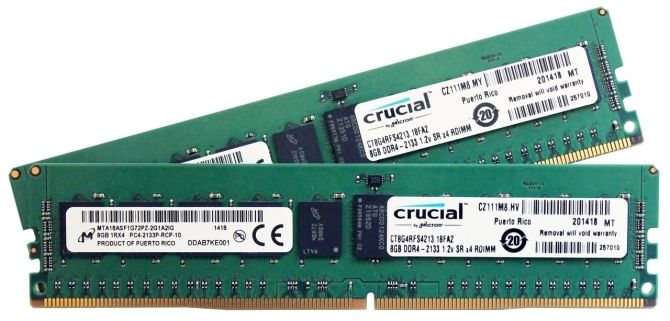
Nosotros tin can explain this using DDR3 and DDR4 as examples.
The lowest speed DDR3 RAM runs is 533MHz, which ways a clock cycle of ane/533000000, or 1.87 ns. With a CAS latency of seven cycles, the total latency is 1.87 x 7 = 13.09 ns. ("ns" stands for nanoseconds.)
Whereas the everyman speed DDR4 RAM runs at is 800MHz, which means a clock bike of i/800000000, or 1.25 ns. Even if information technology has a higher CAS of 9 cycles, the full latency is 1.25 x 9 = eleven.25 ns. That's why it's faster!
For most people, capacity trumps clock speed and latency every time. Yous volition become much more benefit from 16GB of DDR4-1600 RAM than y'all go from 8GB of DDR4-2400 RAM. In nearly cases, timing and latency are the last points of consideration.
ECC
Error Correcting Code (ECC) RAM is a special kind of memory module that aims to discover and right data abuse. ECC ram is used in servers where errors in mission-critical information could exist disastrous. For instance, personal or financial information is stored in RAM while manipulating a linked database.
Consumer motherboards and processors don't usually support ECC-compatible RAM. Unless you are building a server that specifically requires ECC RAM, y'all should stay away from it.
What Is PC4 RAM?
As above, PC4 is another way of detailing the information transfer rate of your RAM. Just where DDR4-xxxx details the per-bit information charge per unit, PC4-xxxxx details your RAM'southward overall data rate in MB/s. You tin find out the total data rate of a RAM module by multiplying its frequency by eight.
Thus, DDR4-3000 refers to a RAM module with a 3000MHz frequency. 3000*viii gives u.s. a full data transfer charge per unit of 24000MB/s.
By extension, PC4 deals with DDR RAM. PC3 deals with DDR3 RAM, and then on. So if someone asks if DDR4 RAM is ameliorate than PC4 RAM, know they're talking about the same thing, but using a different measurement method.
How Much RAM Practice You Need?
Long past are the days where "640K ought to be enough for anybody." In a world where smartphones regularly ship with 4GB RAM or more, and browsers like Google Chrome play fast and loose with their retentivity allocations, RAM frugality is a thing of the by. The average amount of installed RAM is increasing across all hardware types, too.
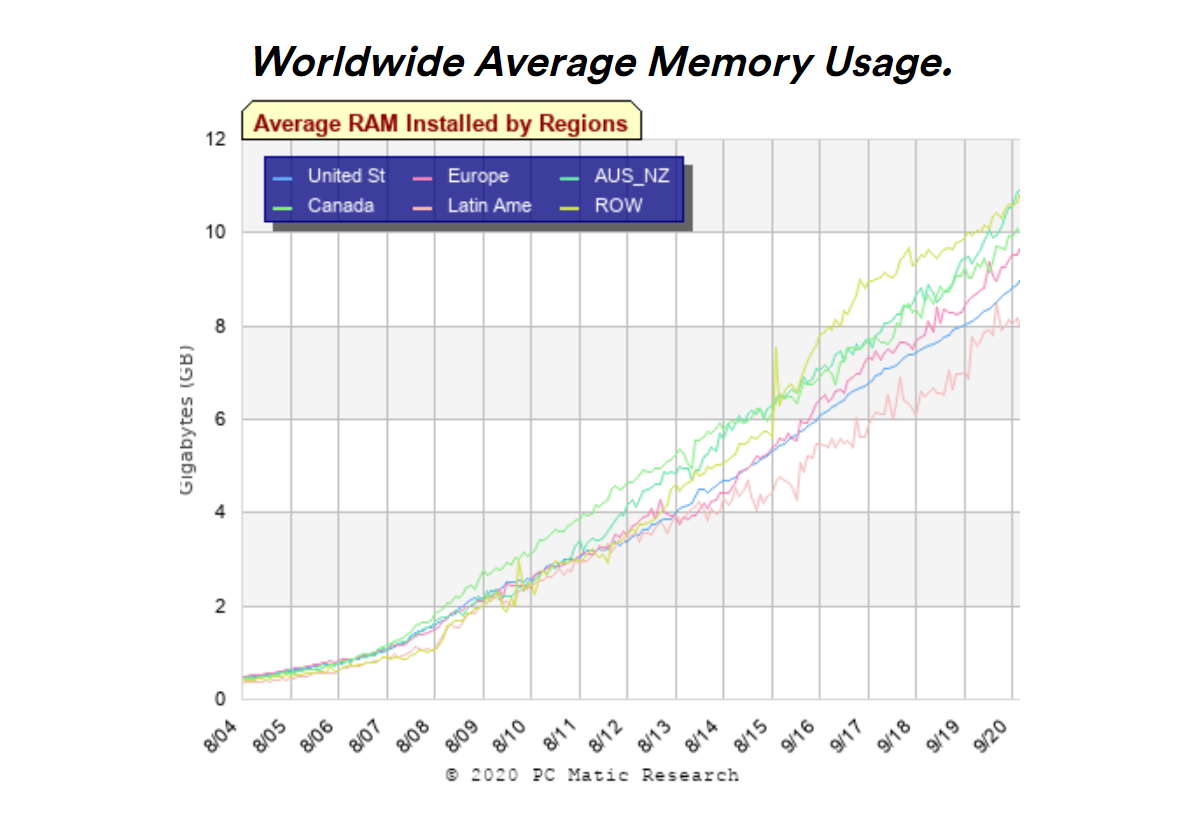
For most people, 4GB is the bare minimum amount of RAM you need for a full general usage figurer. Operating systems have unlike specifications, as well. For instance, you can run Windows 10 on just 1GB RAM, merely you will find your user experience sluggish. Conversely, numerous Linux distributions work extremely well with smaller amounts of RAM.
If you find yourself with half dozen Discussion documents open at any once, can't bring yourself to close those 60 tabs in Google Chrome, yous volition probably desire at to the lowest degree 8GB RAM. The same goes if you want to use a virtual car.
16GB RAM should exceed the needs of most. Just if yous keep utilities running in the groundwork, with a mountain of browser tabs and everything else, you'll capeesh the extra RAM capacity. Very few people need 32GB RAM, only as they say, more is more than.
A RAM upgrade is definitely i of the easiest ways to get an instant operation boost. However, before committing to an upgrade, cheque out these common myths and misconceptions regarding RAM. They'll help you make a better-informed conclusion about how much RAM yous need for your system and whether an upgrade is the all-time choice.
Agreement Everything About RAM
Y'all now know the deviation between DDR2, DDR3, and DDR4 RAM, and you're up to speed on RAM specs.
You tin can tell a DIMM from a And so-DIMM, and you know how to spot RAM with faster transfer rates and higher bandwidth. At this point, you lot're essentially a RAM expert, so information technology shouldn't feel overwhelming next time you lot attempt to purchase more than RAM or an entirely new organization.
Actually, if you have the right class cistron and the corresponding RAM generation, you lot cannot go wrong. Timing and latency do play a role, but capacity is king.
About The WriterSource: https://www.makeuseof.com/tag/quick-dirty-guide-ram-need-know/#:~:text=Clock%20Speed%2C%20Transfers%2C%20Bandwidth,is%20PC3%2C%20DDR4%20is%20PC4.

0 Response to "What Numbers Do You Read on Computer Memory"
Enregistrer un commentaire